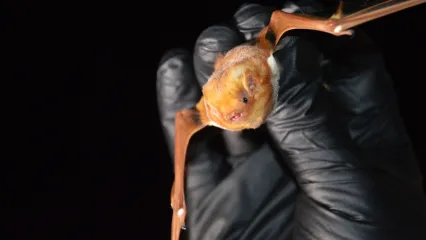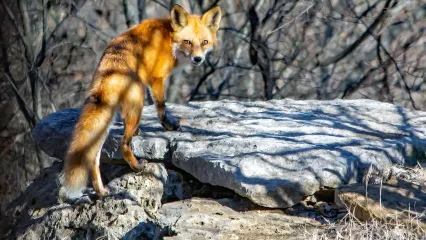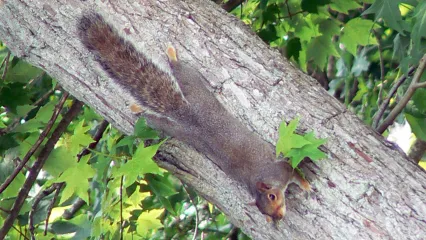
Description
One of the most wide-spread bats of North America, the Eastern red bat is often overlooked - mistaken for a hardwood leaf hanging from a tree or brush pile. Like all bats, the Eastern red bat (Lasiurus borealis) is a member of the Order Chiroptera, true flying mammals. Wings are made of a thin membrane, or patagium, with slender hand bones stretching in flight and folding the wing when at roost. Named for its coloration, it is the only bat with obvious differences between the male and female; males have a deep carrot-red coat while females and juveniles have a duller coat with prevalent white tips. Each individual hair of the red bat is made of four bands. Males have a base color of dark gray, a band of yellow followed by a band of carrot-red with a white band at the tip. Females have a similar arrangement, but the yellow band is wider and the carrot red is replaced with a maroon band, giving them a dull chestnut coat. Both sexes have huffy white patches on the wrist.
Even though the Eastern red bat is one of the most prevalent bat species in North America, it isn't on the top of the food chain. Owls, hawks, house cats, raccoons, and foxes are major predators. Another threat to the red bat is the disturbance of hibernation sites. Although many bats hibernate in caves, the red bat overwinters in tree tops, in bark crevices, and sometimes in brush piles. Because a bats' heart rate drops from over 400 beats per minute to just 11-25 beats per minute while in hibernation, it is very stressful to be removed from a deep leep, find a new place to hibernate, and go back into hibernation.
Size
This bat is four inches long - not including the two inch tail - and weighs only 0.2-0.5 ounces. It is considered a large bat.
Habitat
Although found throughout the eastern United States, this bat is common in the Eastern Deciduous Forest. In Oklahoma, it frequents the eastern half, but has been found as far west as Texas County in the panhandle. Often seen in forested areas, this tree-dweller feeds on insects - especially moths - in early evening. As with other bats, the red bat feeds by way of echolocation. A high-pitched sound wave is sent out while feeding and reflects off an object, hopefully an insect. The bat is able to determine the distance to the insect based on the amount of time it takes for the sound wave to return. Once the bat locates its prey, it either catches the insect with an open mouth, or will use its wings to capture it.
Life Cycle
Breeding season for the red bat is in late summer; bats mate while in flight. Like many other bats, this species has delayed implantation (the egg isn't implanted in the uterine wall until after hibernation). Three to four young are born in the summer in tree-top roosts. While many other bat species only have one or two young, the red bat is able to produce more offspring. Young bats take their first flight three to four weeks after birth, and are weaned two to three weeks later. Find more information in the Wildlife Department's "Bats of Oklahoma Field Guide."


